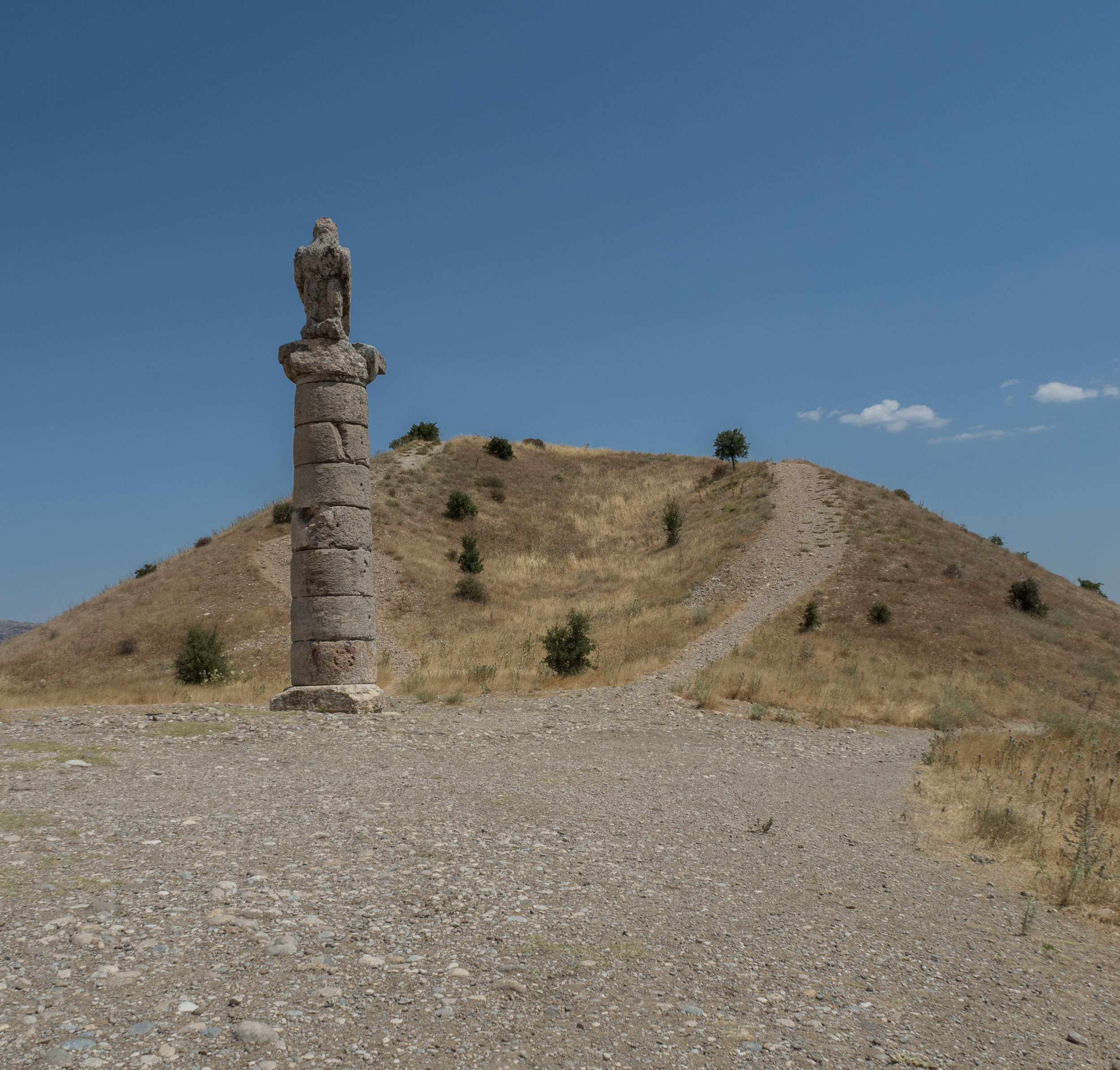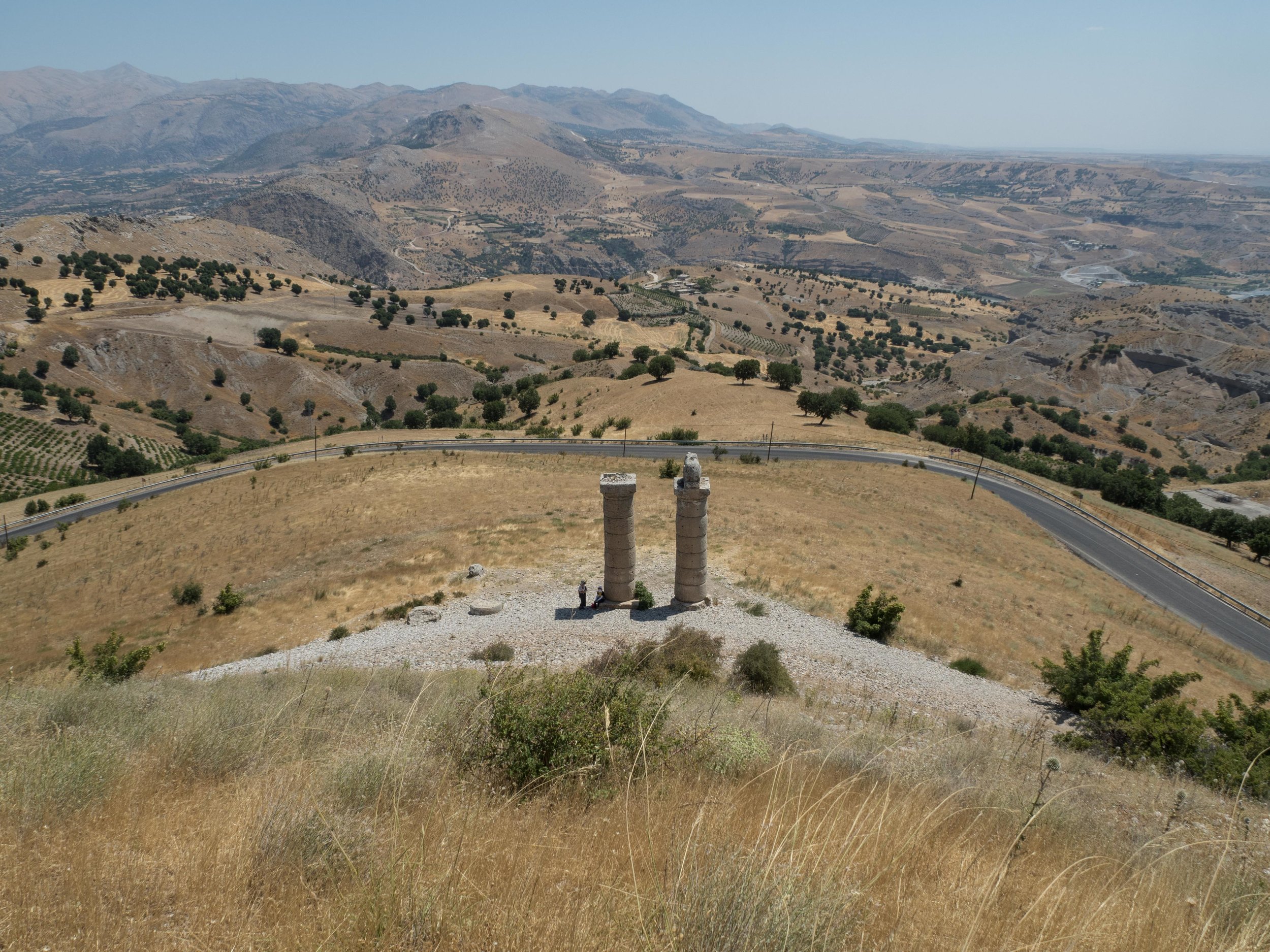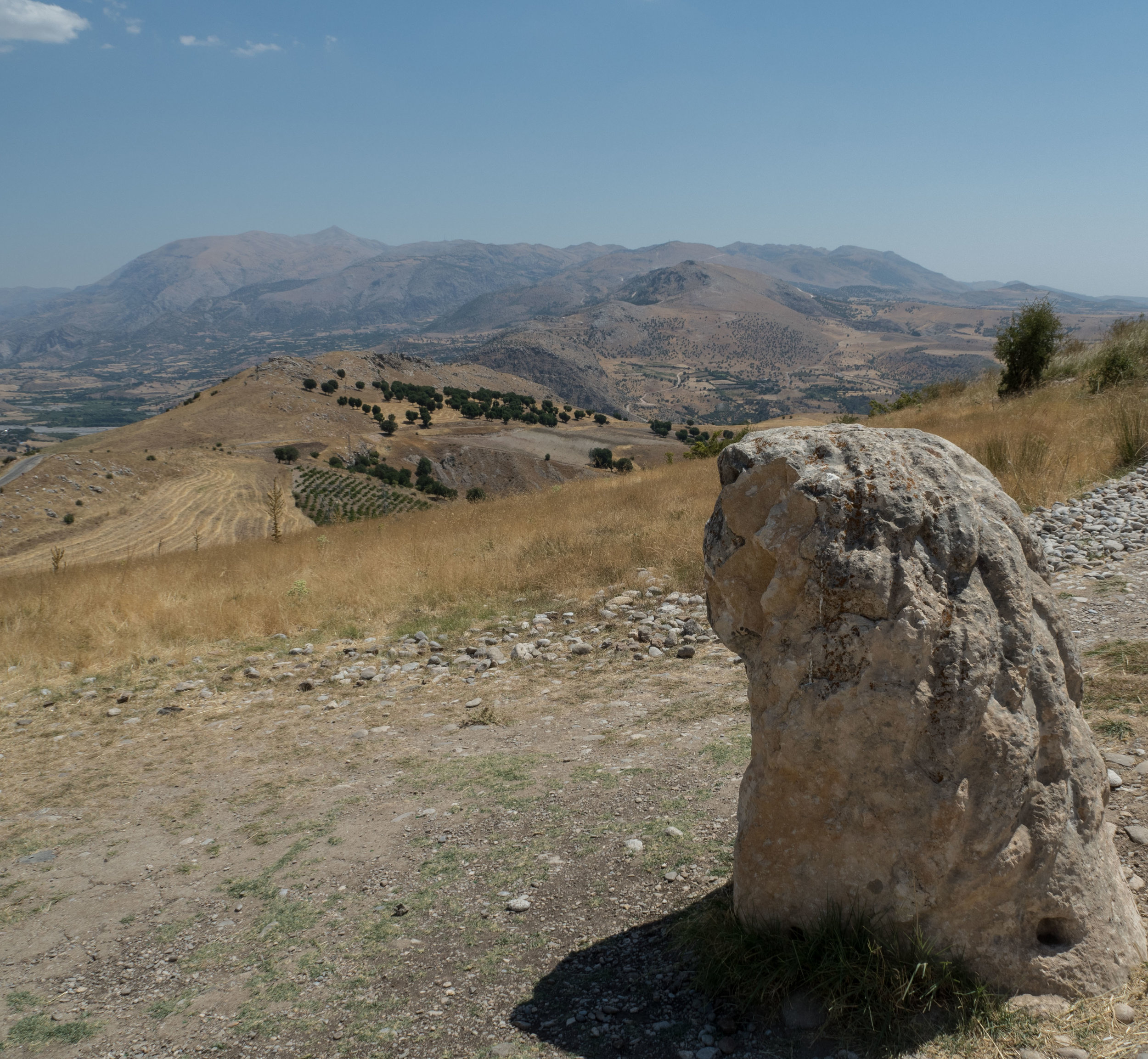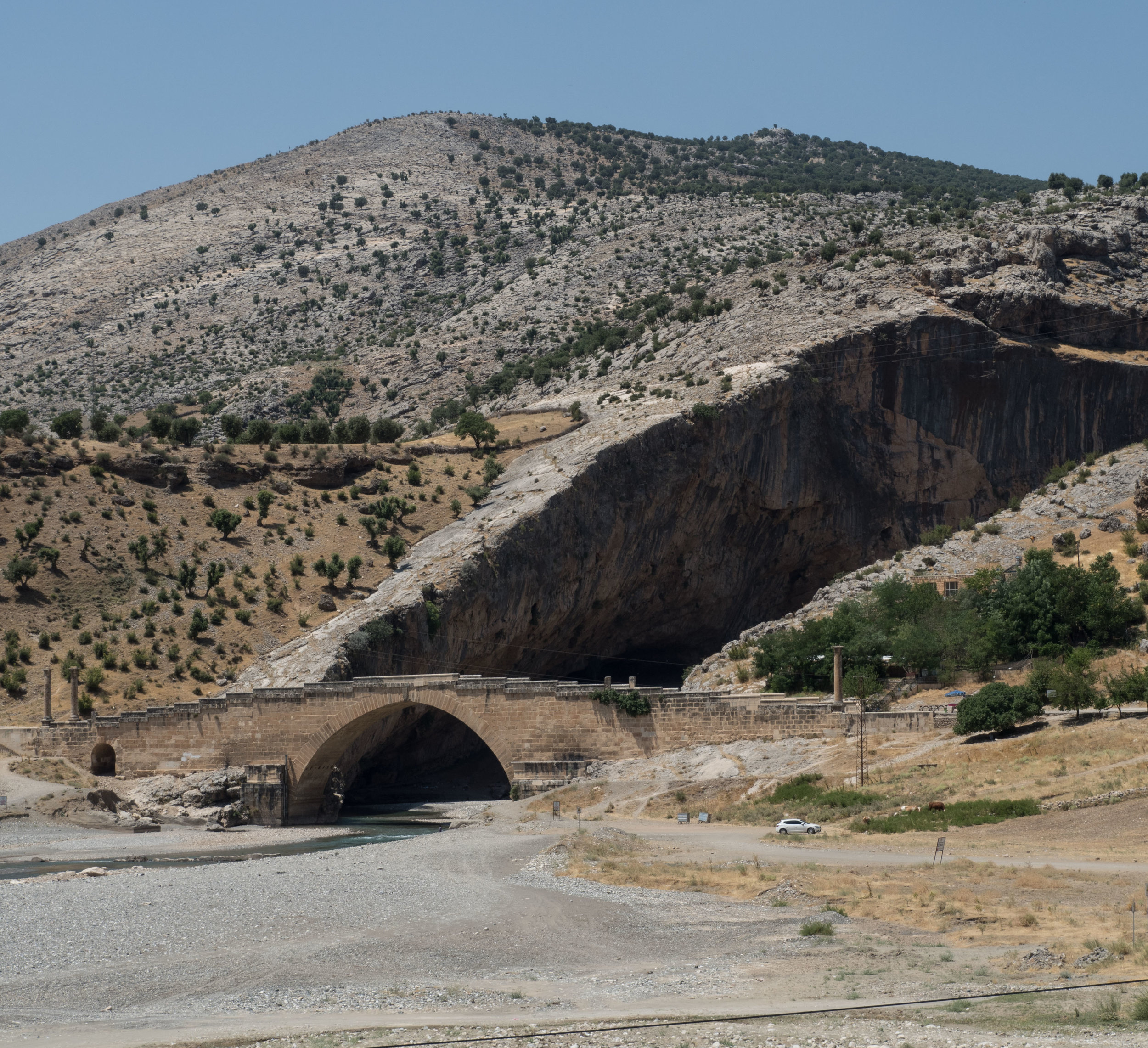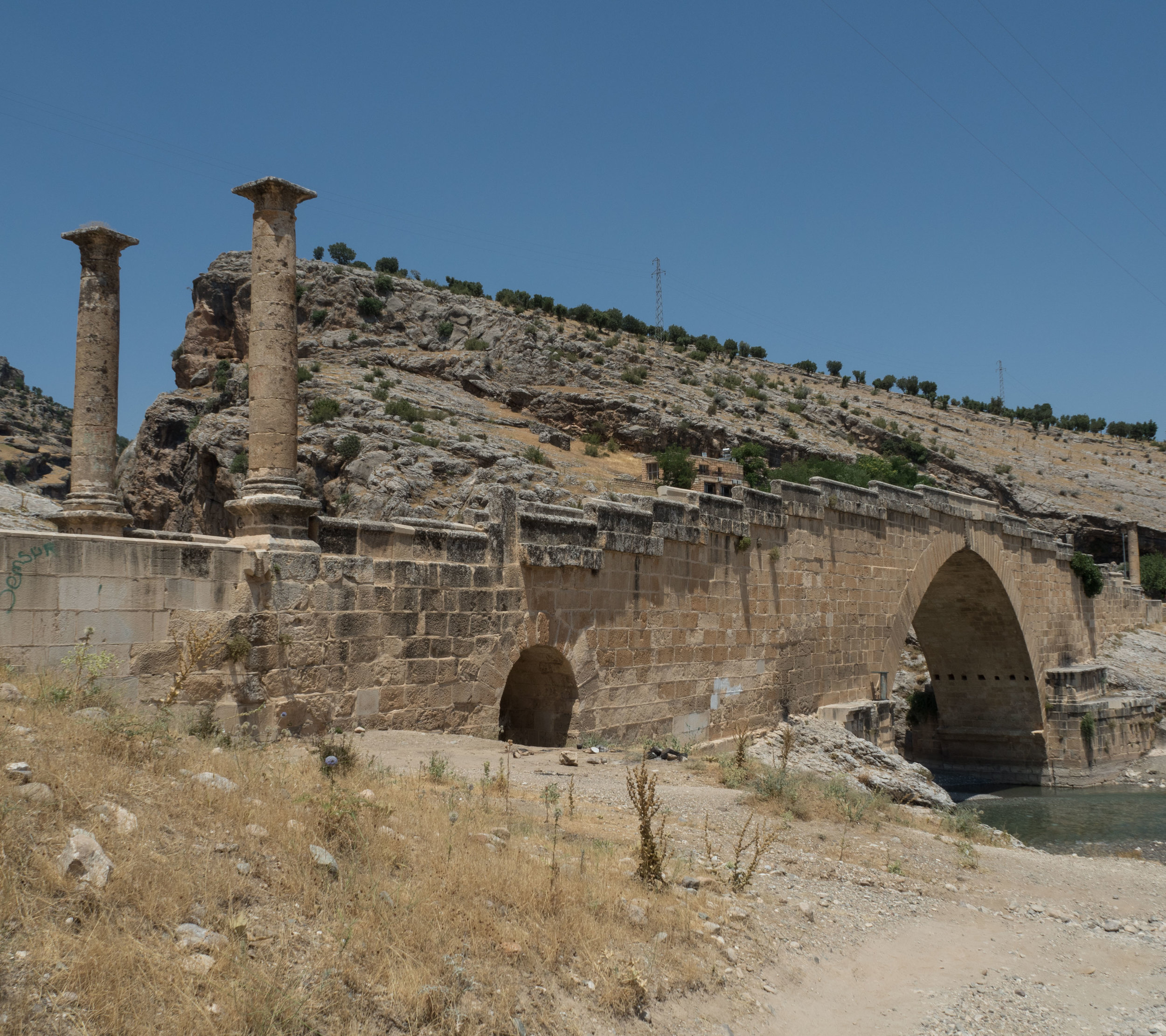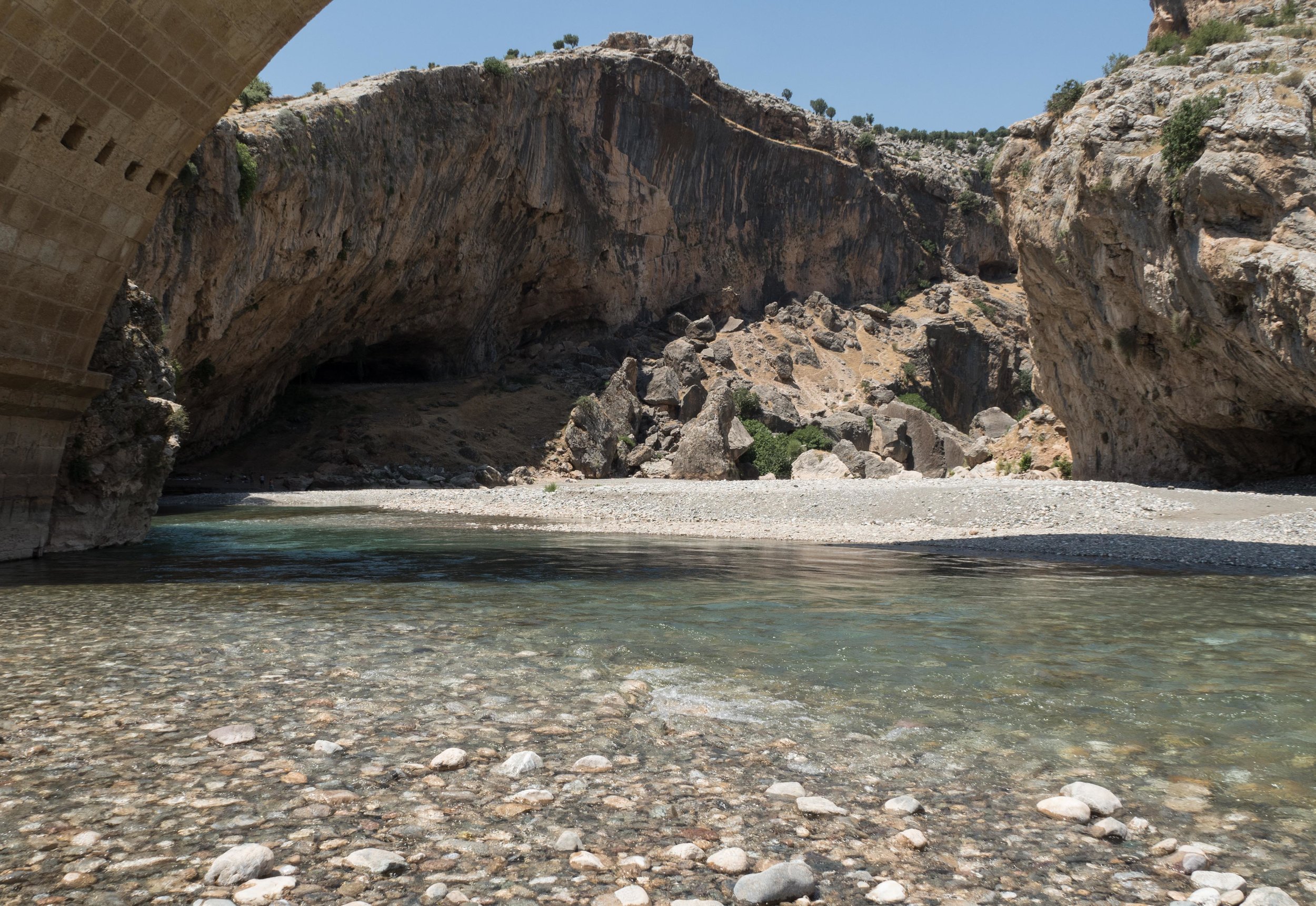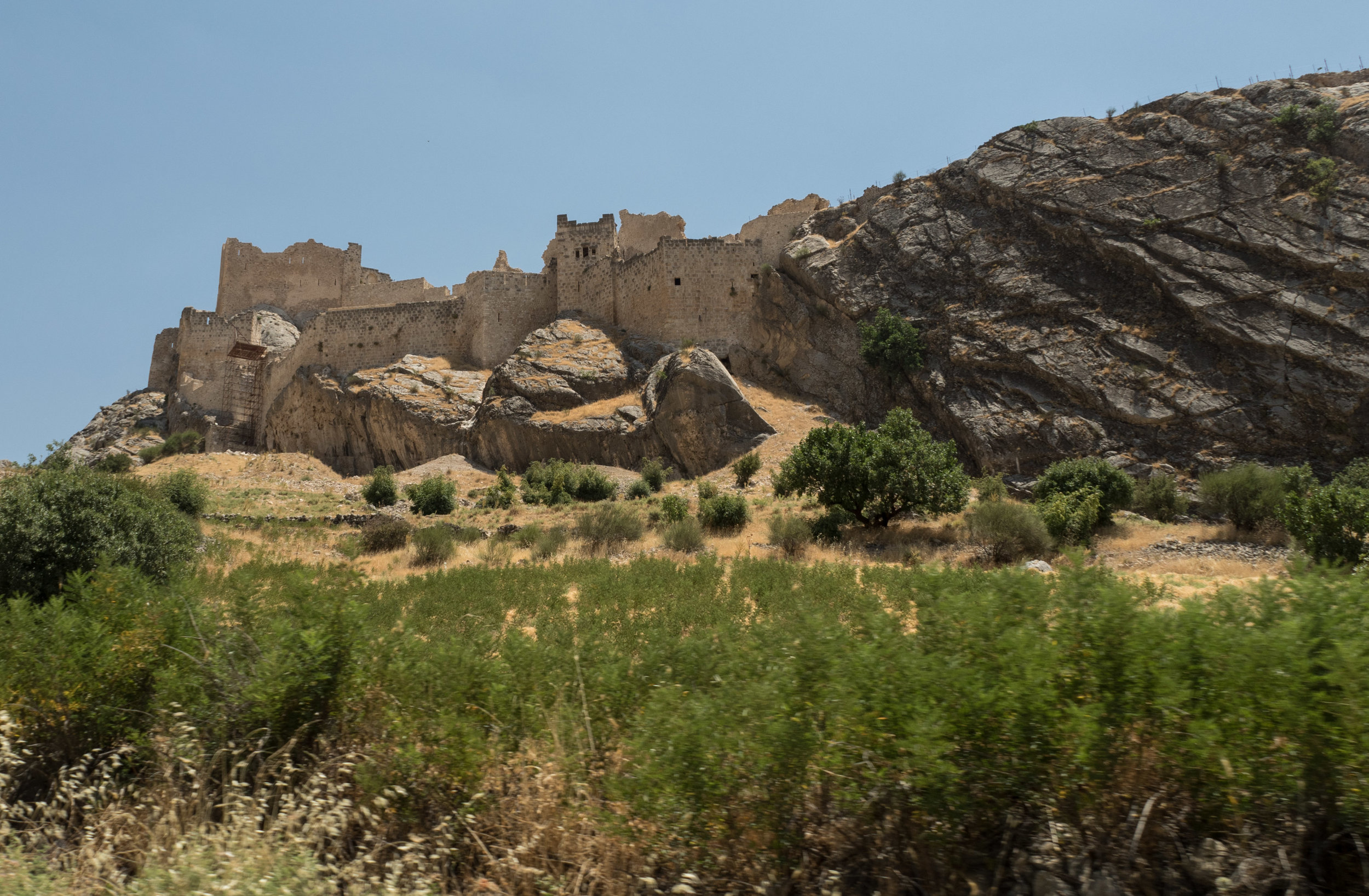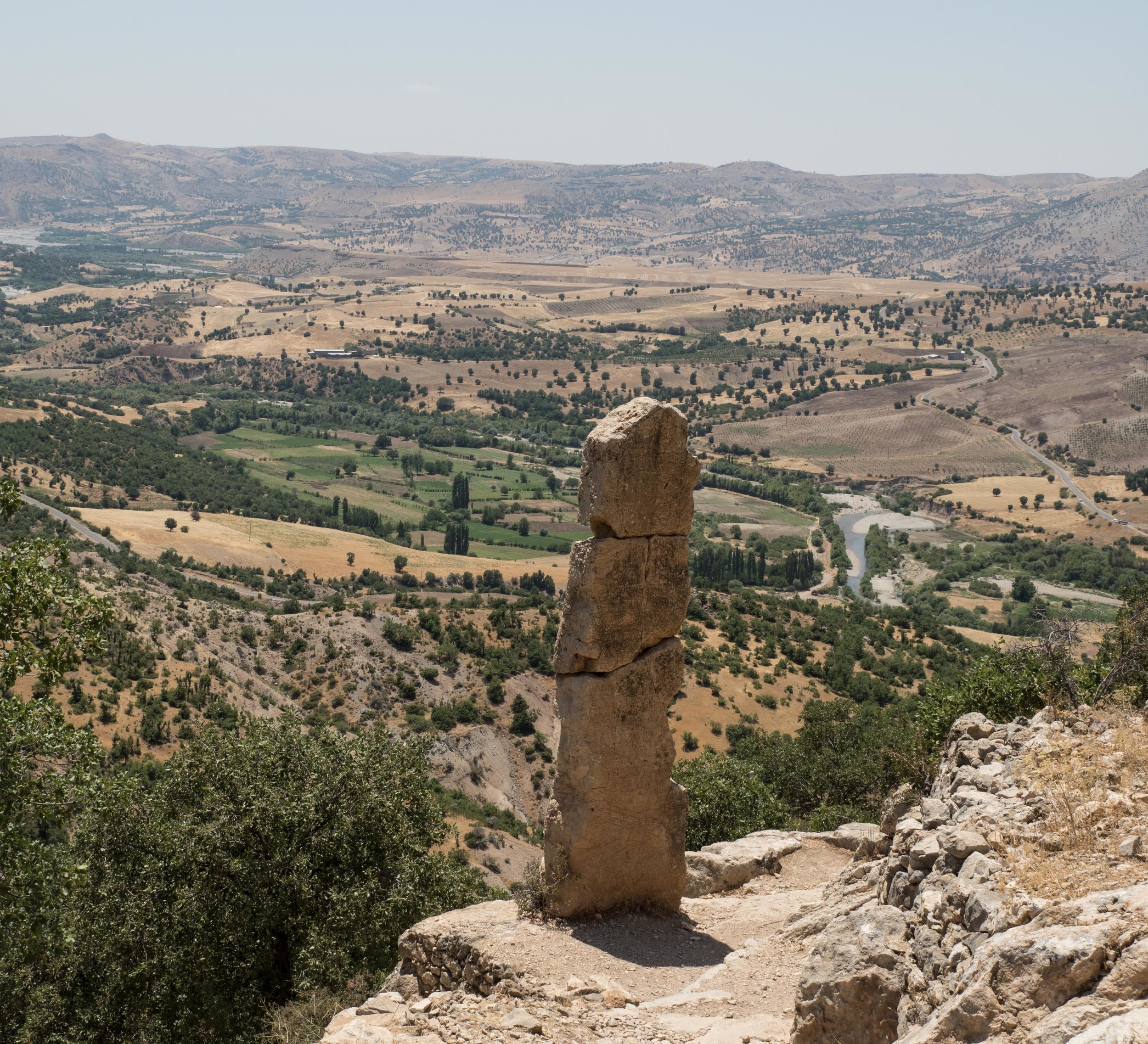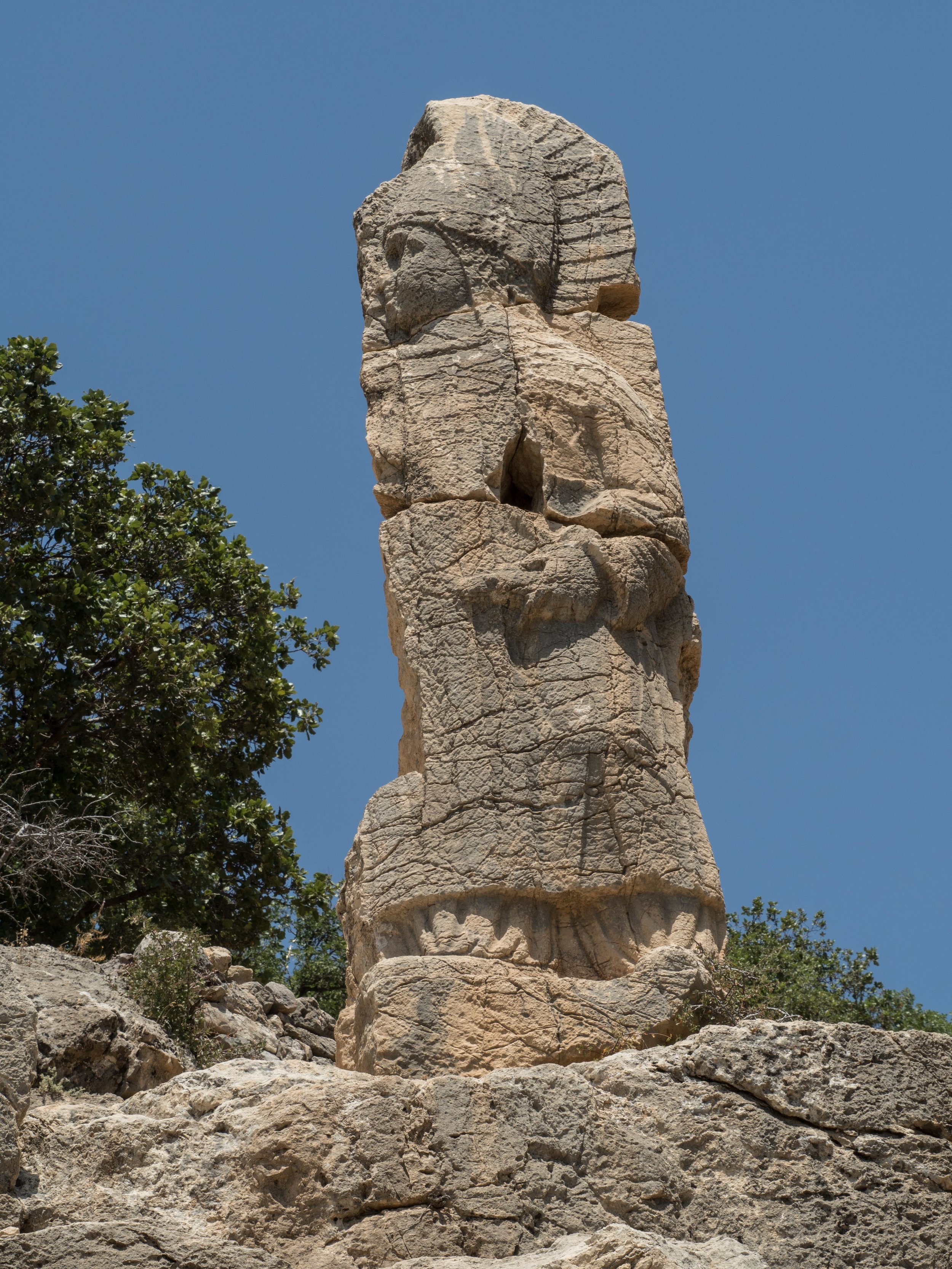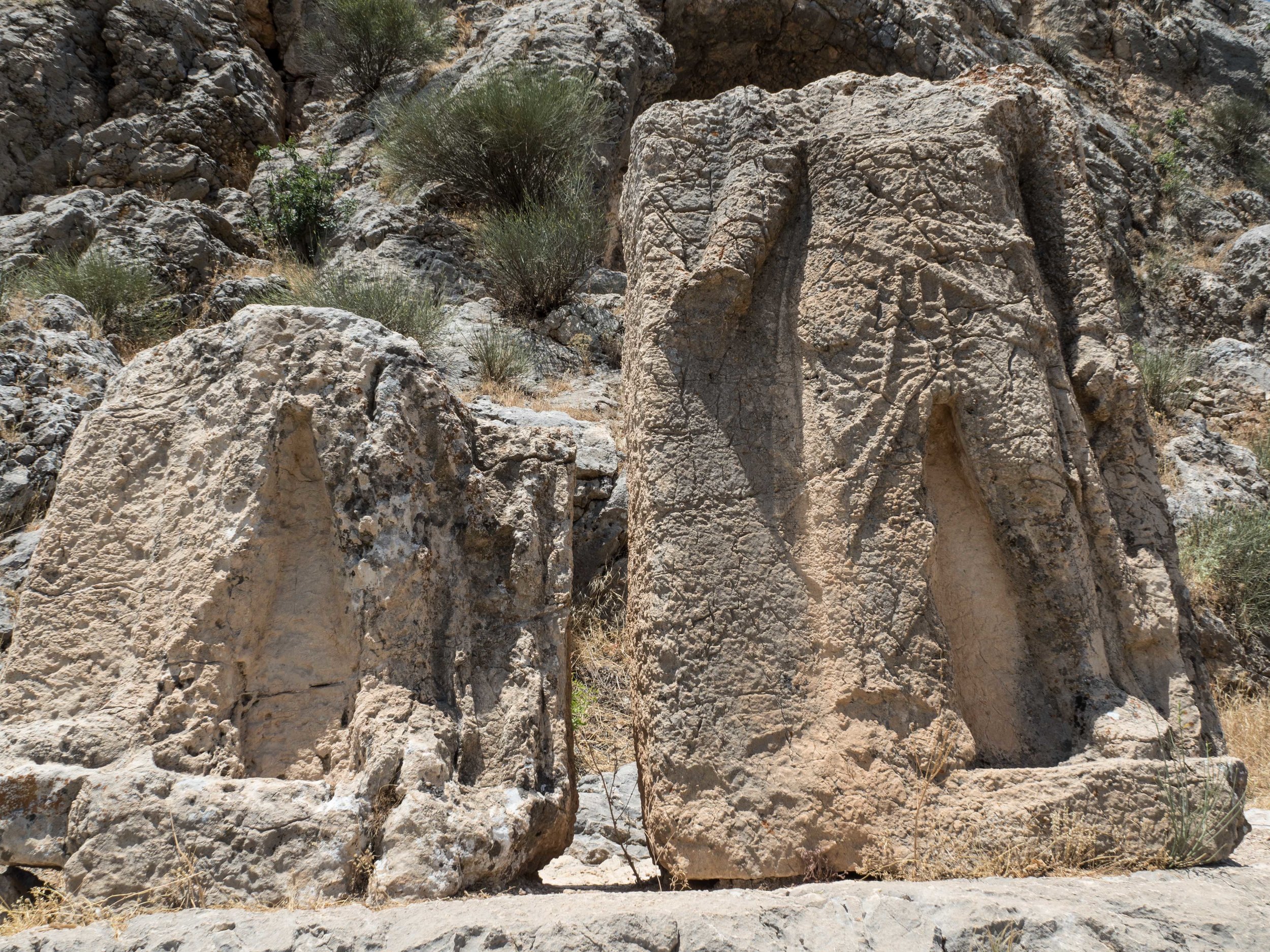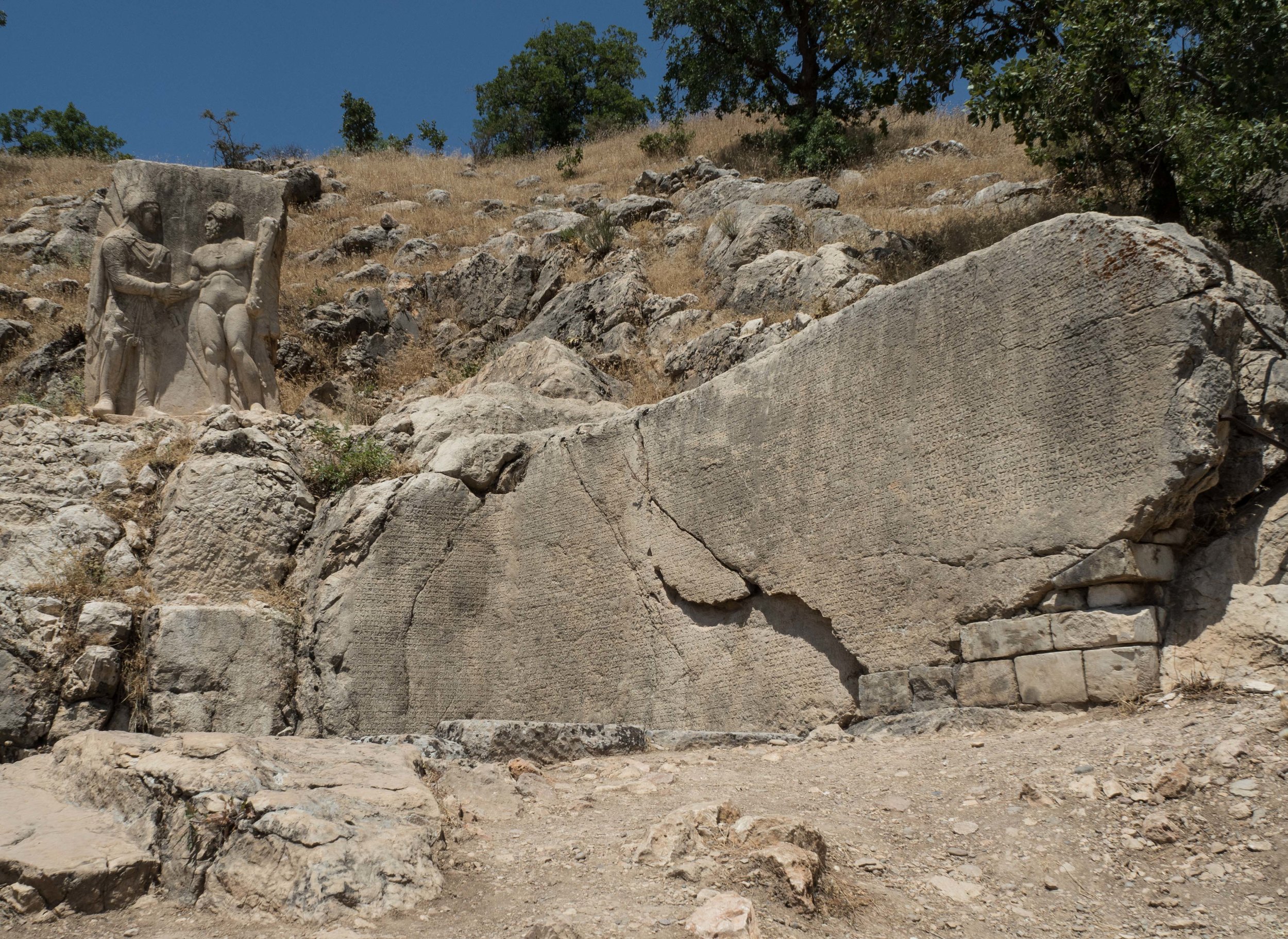This was a sunrise-to-sunset kind of a day. Masoud and I were going to explore the sights in and around Nemrut. This area is not quite known as Kahta Valley, because strictly speaking we are still in the middle of the Taurus Mountains of which Mount Nemrut is the peak. But it felt like a valley to me.
Pretty much, there are four standard sights to see which are all worth your while. Everything can be done in 1/2 a day if you are in a hurry and have your own transportation. I was glad, I had the entire day set aside for it, as that allowed for leisure, tea breaks, and a nap in the afternoon.
First, there is the Karakus Tumulus, built in 36 BC as the final resting place for three female relatives of King Mithridates II, his mother Isias, his sister Antiochis, and his niece Aka. That’s perhaps why it is relatively small and has none of the megalomaniac feeling of Mount Nemrut. But because Mithridates II was a successor Antiochus I who built Mount Nemrut, there are similarities: Stone monuments surround the burial mound. In this case, a few columns with some animal capitals are left standing. The sign mentioned a relief in addition to the columns in which Mithridates II is shaking hands with another sister named Laodike, but for the life of me, I could not find it. Most likely, in the olden days there was a whole circle of columns around this monument? But as we know from other sites, Cut stones making up these columns are fantastic building materials…
Masoud would not leave the shady tea house to suffer the wrath of the sun with me, at a site he had seen dozens of times. I was on my own. I prefer that, but perhaps I missed a hidden corner that way. Oh well…
Both Mount Nemrut and this burial mound are created by piling up gravel, rather than quarrying large boulders, as is the case in the Egyptian Pyramids of Giza, for example. The rocks are rarely larger than fist-size. Overall, this kind of a loose rock pile does not look durable. But then, it has lasted 2000+ years… Despite the sign that says you cannot climb the tumulus, the understanding is that you only cannot climb the columns… Who could anyhow?! So I climbed the mound and had stunning views of the surrounding area.
And that was pretty much the theme of the day: Stunning views wherever you look! You can only stop so many times and take pictures… And the pictures I took just did not do justice to the reality of these rolling hills, green vegetation, yellow fields, bizarre rock formations, castles, winding rivers, stone villages, and here and there the turquoise outskirts of the Ataturk Reservoir. Just marvelous. And hot, of course!
The second sight in the area is Cendere Bridge, a 2nd century Roman “humpback” bridge over the Cendere or Cabinas River. It has an inscription panel in Latin that states that it was build during the reign and in honor of Septimius Severus. Three of four columns still stand, marking once in pairs the entrances to the bridge. They commemorate the emperor and three family members: his wife Domna, and their sons Caracalia and Geta. One column was removed by a later emperor because Geta was killed and presumably fell out of favor? Too bad for the bridge. But three is still better than none. These columns make for a nice stately appearance enhancing the wonderful curve and stonework of this marvelous bridge. The river below is shallow and I was quite tempted to walk through. But the current is so strong, and the riverbed so rocky, I would have jeopardized both myself and my brand-new camera. And for the camera’s sake I did not. But in this scorching heat, nothing sounded better than to put at least your feet into the water. But I caved in to common sense and had a cup of hot tea at the little bridge restaurant instead, if that makes any sense.
Next to all of these sites that are frequented by visitors, there are at least one if not two places where you can have tea, coffee, water, juice, or food. And all of them sell this or that souvenir, mainly little rock carvings of the Mount Nemrut statues, the bridge, and so forth. And if you just can’t help yourself, you can also buy some sun-bleached, dusty rugs here…
I was almost grateful, that the third sight in the region, an impressive 13th Century Mamluk Castle (Yeni Kale) was closed for restoration. I could not have missed climbing it had it been open, but in this heat…?! There used to be one the ancient BC Commagene Palaces there which is gone now. Once again there were spectacular views of the valley along the way and back down.
Yeni Kale Mamluk Fortress
The owner of the coffee terrace across from the castle — whose business has suffered greatly over the last ten years with the castle closed — convinced us to stop for his very special pistachio coffee. Masoud hated it and I, only out of a sense of courtesy, finished my cup. Turkish coffee just isn’t my thing. But the owner had made it sound like a specialty rivaling the one we had at the Sanliurfa bazaar… far from it. I am still glad we stopped and helped the local economy at least with a cup of very expensive coffee.
Best of all Khata valley sites: Arsameia on the Nymphaios, the summer capital of the ancient Commagene Empire. The site goes back to the founder of the empire, King Arsames, an ancestor of Mithridates and Antiochus, and was discovered in the 1950’s by the German archaeologist Friedrich Karl Dörner.
What can I say, the Germans were and are everywhere! From Schliemann to Schmidt to Dörner; what is it about the Germans that they can’t help snoop around everywhere? And to their credit, they have made major contributions to not only archaeology but art history. That field would not exist quite the same way without the foundations of a Johann Joachim Winckelmann and many others. Perhaps, that’s why I became an art historian? It was in my cultural genetic makeup. :-)
The views from this site topped all the previous ones. Masoud was very relieved when I excused him from accompanying me on this “dangerous” site. What’s dangerous here? Will I be mugged or robbed? No, there were not any dangers caused by humans, in fact, there was not a single other visitor besides me; but the path was rough, full of loose rubble, and at times quite steep. I could fall and break something. The warning was well placed. At times, I was maneuvering the path on my butt to avoid slipping. And while I roughed the scorching sun, Masoud hung out with the owner of the deserted tea shop. No entrance fee and no visitors. Well, not none, but perhaps a few every hour or so. I could not believe it. Hundreds of people flock daily to Mount Nemrut only a few miles away, and this gorgeous site slumbers along as if forgotten by all but a few.
This once was an acropolis, a palace, and the final resting place of Mithridates I built for him by his son Antiochus I. In addition, you have various relief carvings, caves, and inscriptions that have been identified by Dörner. There is a stele of Mithras/Apollo probably shaking some unidentified person’s hand. It is worth noting that Zoroastrian roots here merge with some Greek religious ideas; syncretism of the finest order.
Higher up, there are Mithridates I and Antiochus I with a scepter and an inscription. Two deep caves are found on site; one used for food storage that is easy to climb into. The other, a 158-meter deep ritual gathering place. I climbed as deep as I could. That got really dangerous and half-way down I thought the better of it and turned around.
And finally, there is the impressive and nearly completely preserved (or rather restored) Hercules shaking Mithridates’ I hand. They seem to like these hand-shaking steles around here, perhaps, since the Commagene empire really was the “hand-shaking” buffer zone between the Seleucid Empire of Parthia and the Ptolomies of Egypt, thriving at least for a few centuries on getting along with both sides and keeping a tumultuous region at relative peace.
The extensive Greek inscription found at the entrance of the second cave is about the founding of Arsemeia and is considered the longest and most comprehensive Greek inscription in all of Anatolia. If the sun would have not have taken its toll, I would have climbed around this hill even further, but getting this far was a taxing but worthwhile climb covering most of the sites except the very top.
As we wound our way up Mount Nemrut driving around in search for a road back to Karadut, where our Pension was located, passing tiny villages and taking this or that unmarked fork in the road, Masoud turned to me and gestured: So, how would you have done all of this without me driving? Well, that was the $100 question. Never in my life would I have found my way around these little roads on my own. Much of this day probably would not have happened without Masoud. Would I have given the car back? Would I have hired another driver? Something would have happened that would have turned my stupid idea of driving a car in Turkey around. But I don’t quite know what. Masoud was definitely the right choice.
After a well-needed rest at the Pension, I embarked on a sunset climb of Mount Nemrut. But that is worth a new blog entry.
See you there tomorrow.
